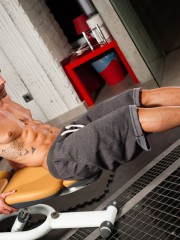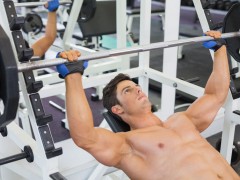New to Working Out – Why are You so Sore?
 If you’ve never set foot in a gym before, or if you haven’t really moved but to get from the couch to the bathroom in a number of years, odds are that your initial trip (maybe several trips) into the world of fitness could be a pain in more ways than one. Even if you take it slow during your first workout, you are very likely to experience some soreness from your effort.
If you’ve never set foot in a gym before, or if you haven’t really moved but to get from the couch to the bathroom in a number of years, odds are that your initial trip (maybe several trips) into the world of fitness could be a pain in more ways than one. Even if you take it slow during your first workout, you are very likely to experience some soreness from your effort.
It used to be a common belief among even the more educated trainees that the residual soreness from working out was caused by a build up of lactic acid in the muscles that you worked particularly hard. “Gym rats” were of the belief that once you got to the point in your routine where you were “feeling the burn” that there was a good chance of soreness the next day due to an excess of lactic acid being released into the muscles. In order to get rid of the lactic acid you would put those same muscles through some sort of work the following day to help “blow out” or expel the lactic acid from the area and thus eliminate the soreness.
While the “lactic acid theory” may not be entirely accurate scientifically, the methods you can go about using to help get rid of residual muscle soreness are very similar to what was prescribed to get rid of said buildup. What happens when you put your muscles under extreme stress is that the fibers actually get damaged. Though we never usually associate any kind of damage as a good thing, this damage is highly desirable as it will ultimately lead to gains in both size and strength.
The damage done to your muscles during a vigorous workout is nothing to be afraid of; it won’t lead to any kind of  prolonged injury or permanent damage and, truth be told if you don’t do that damage to your muscles you will never progress. This damage to your muscle fibers causes the release of chemicals, increased blood flow and swelling – all of which are contributing to your soreness.
prolonged injury or permanent damage and, truth be told if you don’t do that damage to your muscles you will never progress. This damage to your muscle fibers causes the release of chemicals, increased blood flow and swelling – all of which are contributing to your soreness.
The key to feeling better is “the hair of the dog that bit you,” as the old time drinkers used to say of recovering from hangovers. Meaning, in that case, that if you drank too much the previous night a cold beer or stiff mixed drink this morning will get you going – though that form of recovery rarely leads to anything positive applying the same course of action for your sore muscles will certainly do the trick (not booze, more working out).
You don’t want or need to perform another vigorous workout targeting your sore muscles, because that won’t let them recover properly from the damage that occurred during your workout, but you do want to get the blood flowing through those areas that are sore and get in some light to moderate activity in the sore muscle to eliminate the soreness. This is often referred to as “active recovery” and is pretty much the only way to get your body feeling normal again after a particularly tough workout.
Say you worked your legs hard for the first time in God knows how long – you did some pretty heavy squats, a spirited bout of leg presses and finished off with some leg extensions and leg curls – now you can barely get out of bed to shower, what do you do?
As much as you may hate to hear it, you’re gonna have to man up and get moving. Drag your butt out of bed, or off the couch and get outside for a brisk walk (or even light jog), nothing to crazy, just enough to get the blood flowing – this will be better than jumping right into an activity that will put more of a direct focus on your legs.
Once you’ve completed your walk do some light stretching for about five to ten minutes and then get into some specific movements to very lightly hit the muscles that are sore. Some good choices would be a few sets of bodyweight squats  or bodyweight lunges followed by some more light stretching. I’m not going to lie – this is going to hurt, regardless of what muscles are sore – when you start pushing the blood back into them it’s going to hurt, but once you’ve made it past the first few minutes the pain will begin to subside and your soreness will gradually go away. After investing about twenty minutes of your morning you can be back to functioning like a normal human again.
or bodyweight lunges followed by some more light stretching. I’m not going to lie – this is going to hurt, regardless of what muscles are sore – when you start pushing the blood back into them it’s going to hurt, but once you’ve made it past the first few minutes the pain will begin to subside and your soreness will gradually go away. After investing about twenty minutes of your morning you can be back to functioning like a normal human again.
This day after soreness is likely to continue until your body becomes more accustomed to the rigor of your workouts. As time progresses and you get into better shape you’ll have to change and modify your workouts so that you can continue to progress, and with each change you can probably expect at least some residual soreness the following day – but it probably won’t ever be as bad again as it was after your first few workouts.
Just keep telling yourself as you force your way through your morning after active recovery that the soreness means progress and push through – the first week or two will be the worst and then you can start to really enjoy your workouts and how they make you feel.
Keep in mind that this remedy only applies to sore muscles – if you are experiencing intense pain in your joints or muscles, excessive swelling or bruising you should consult with your physician to see where the problem is stemming from. Before beginning any new workout program it’s best to get a once over from your family practitioner just to get the thumbs up.

Do girls leave you confused as to whether or not they like you?
Let's face it. Girl's don't make it easy for you. She will often send mixed signals leaving you unable to tell if she is being friendly or flirty. If you read her signals wrong you risk rejection and embarrassment. Or worse, you blow it with a girl who wanted to kiss you.
Here is a simple and innocent move that will instantly tell you if you're in the friend zone, or if she's waiting for you to kiss her.
 We respect your email privacy
We respect your email privacy
About Jeff Wilson Jeff Wilson has been involved in some form of sports and athletic training for more than two decades: as an athlete, a trainer and a writer.